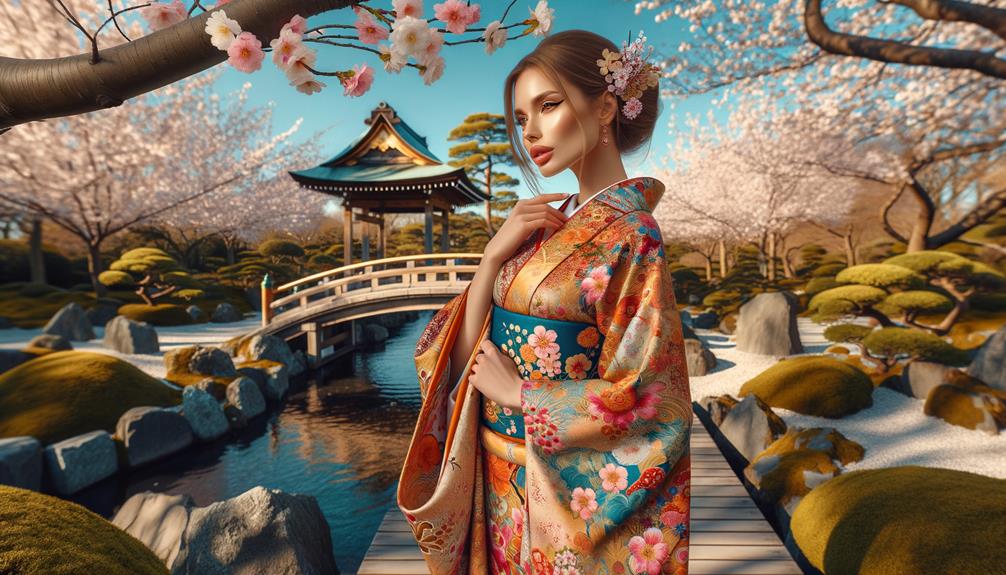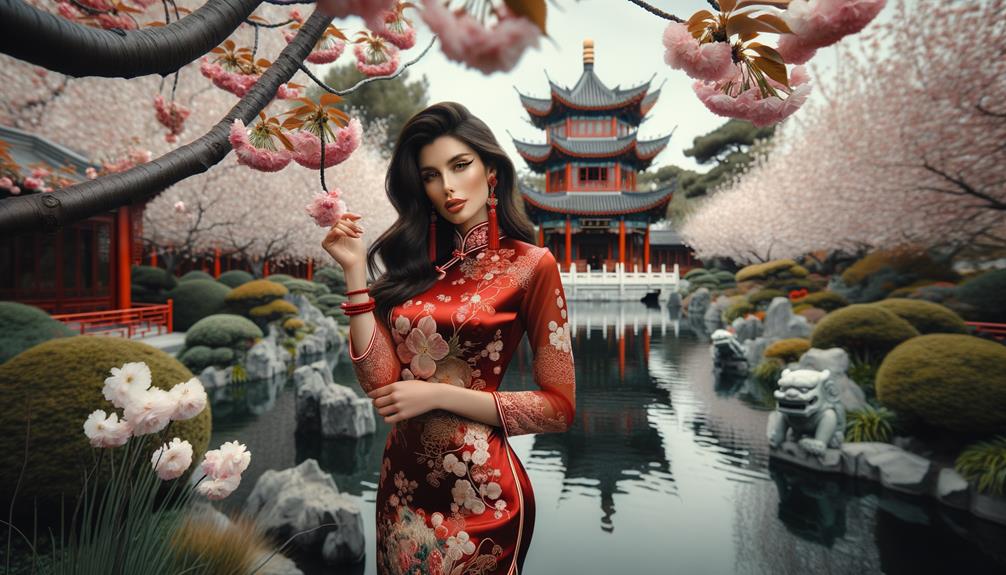Over 70% of Norwegians own a traditional folk costume known as the "Bunad," despite the significant cost and intricate craftsmanship required. This cultural affinity speaks volumes about the deep connection these garments foster. Each Bunad features meticulous embroidery and symbolic patterns, narrating a unique story of regional identity and heritage. Seeing someone wear a Bunad evokes curiosity about the history and traditions interwoven into the fabric. What compels modern Norwegians to embrace these costumes? There's a rich narrative beneath the surface.
History of Bunads
Bunads emerged from a desire to reconnect Norwegians with their cultural roots as the nation industrialized in the 1800s. Driven by romantic nationalism, people revived traditional rural clothing as symbols of regional pride. Today, these intricate folk costumes represent more than fashion – their distinct designs narrate stories of local customs and history.
Each region's bunad bears its own tale through colors, patterns, and accessories specific to its origins. These garments hold an esteemed place, gracing celebratory occasions like weddings and parliamentary events. Organizations like the Norwegian Institute for Bunad and Folk Costume play a vital role in meticulously preserving these cultural treasures, ensuring their stories continue weaving the fabric of Norwegian identity.
Regional Variations
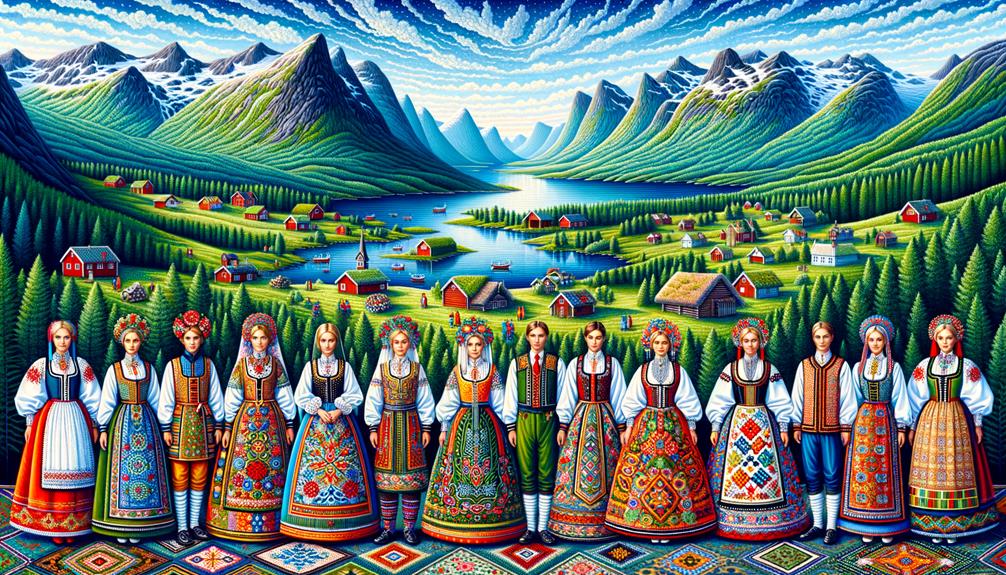
Browsing through Norway's bunad collection, each region showcases a distinct personality through vivid hues and intricate patterns. The carefully chosen fabrics and symbolic embroidery seem to narrate diverse cultural tales from every corner of the nation. These regional variations offer more than just aesthetic appeal; they represent deep-rooted traditions and identities.
Color and Patterns
Each corner of Norway tells its unique story through the striking colors and intricate patterns woven into their traditional bunads. These vibrant folk costumes continue to captivate, serving as canvases for expressing regional identities. The color palettes and patterns aren't arbitrary but carefully chosen, reflecting the histories and narratives unique to each area.
For example, the embroidery on a bunad from Hardanger might feature simpler, more geometric motifs, while one from Telemark showcases elaborate floral designs. These regional variations celebrate not only aesthetic beauty but also the stories and heritage of the people who wear them.
It's remarkable how each bunad can connect wearers to their ancestors through every stitch and hue. The reds, blues, greens, and golds commonly seen in these costumes symbolize centuries-old traditions and local pride. Observing the detailed embroidery work allows one to glimpse history, a testament to the enduring cultural identities represented by these color schemes and patterns.
Material and Fabric Choices
Diving into the fabric selections of Norwegian bunads opens a captivating window into each region's cultural heritage. Wool, a staple in colder areas, offers warmth and durability, often paired with rich hues and intricate designs mirroring the rugged yet vibrant landscapes. Regions with milder climates favor silk for its luxurious sheen and texture, complemented by delicate colors and patterns exuding elegance. The versatility of breathable cotton lends itself to simpler yet equally meaningful designs where comfort meets tradition.
These regional fabric choices speak volumes about the environmental influences and cultural roots shaping each bunad. Material quality and craftsmanship reflect not just cost but authenticity, making every bunad a unique wearable piece of history worth treasuring.
Symbolic Embroidery Designs
Exploring Norwegian bunads' intricate embroidery patterns takes you on a captivating journey through regional traditions and historical narratives. Every stitch on these folk costumes narrates a tale, seamlessly blending cultural elements and past events. What fascinates me is how the designs distinctly vary across regions, each a unique reflection of heritage and local customs.
The symbolic patterns showcase meticulous attention to detail. Floral motifs are widespread, their vibrant hues and delicate shapes infusing nature into the fabric. Often symbolizing growth, fertility, and seasonal changes, these motifs deeply resonate with Norway's agricultural roots.
In certain regions, geometric patterns and specific symbols predominate, each carrying historical and cultural significance. These designs serve as visual archives, preserving communities' stories and values through generations. The craftsmanship behind creating such intricate patterns is awe-inspiring, exemplifying not just skill but a profound connection to heritage.
As I study these bunads, I'm struck by how innovatively they preserve tradition. Every thread connects the past to the present, celebrating a rich cultural tapestry through meticulously embroidered details.
Craftsmanship and Materials
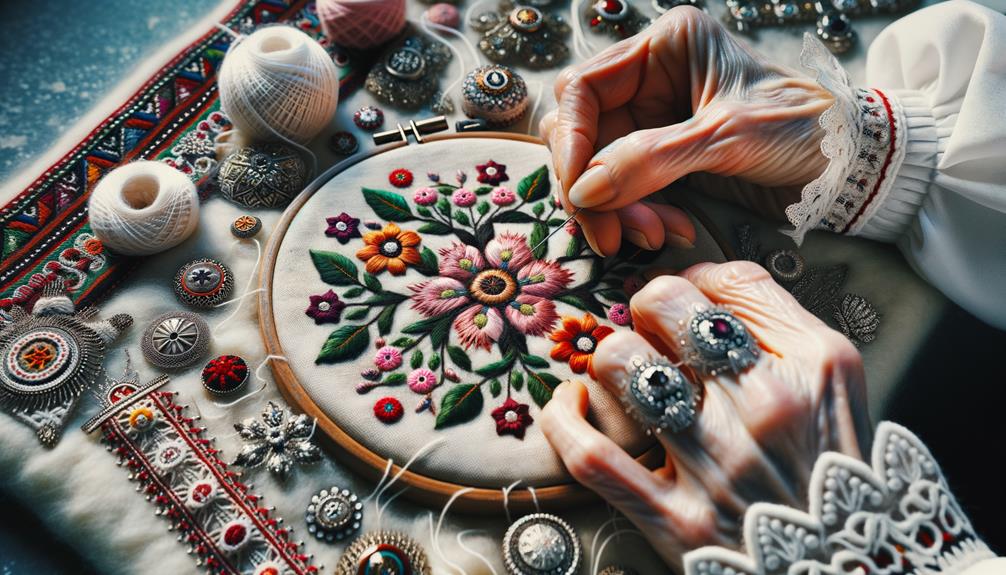
Norwegian folk costumes aren't just clothing – they're meticulously crafted artworks. Talented artisans spend months hand-sewing intricate embroidery and detailing, ensuring cultural authenticity with premium materials like wool, silk, and cotton. This incredible craftsmanship lends durability and historical accuracy to each bunad.
These traditional outfits shine with handcrafted silver jewelry and filigree accessories that perfectly complement the cultural narrative. Every element contributes to the bunad's beauty and significance. From locally sourced materials to painstaking attention to detail, these costumes demonstrate a profound commitment to preserving Norwegian heritage through exceptional craftsmanship.
Occasions for Wearing
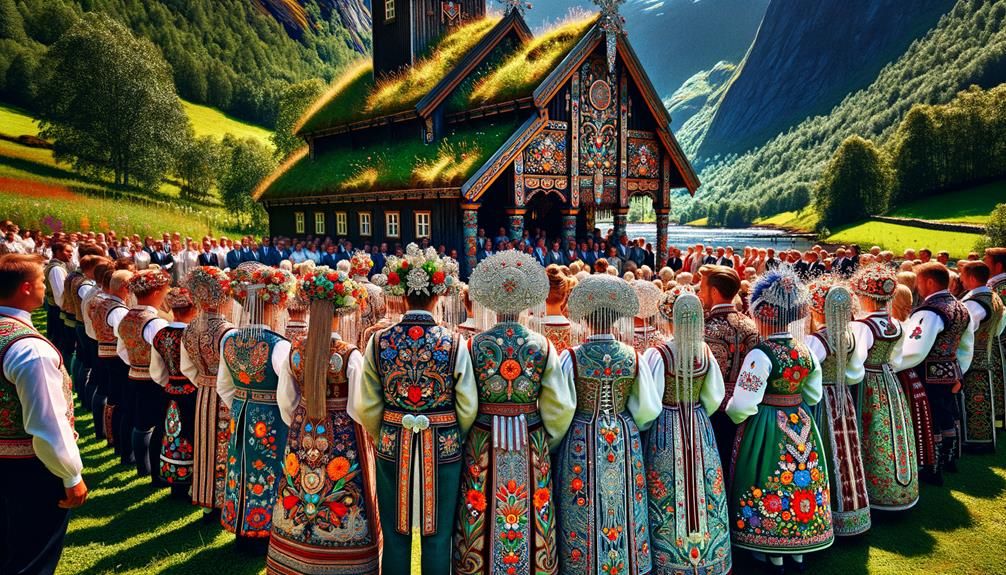
Wearing bunads immediately brings Norway's Constitution Day to mind – vibrant parades and national pride on full display. These detailed garments also mark family milestones like weddings and baptisms, infusing them with deep tradition. Observing how both men and women cherish donning bunads connects me to our cultural roots.
National Holiday Celebrations
The streets come alive on May 17th as Norwegians proudly don their bunads, transforming the national holiday into a vibrant celebration of heritage. These intricate folk costumes, with distinct embroidery and colors, represent the diverse regional identities that form the nation's rich tapestry.
Wandering through the festive scene, patriotic songs fill the air, and the array of bunads creates an almost cinematic display. These traditional dresses, steeped in history, evoke contemporary emotions of unity and pride during the celebrations. Donning my bunad connects me to my roots, sharing a timeless tradition with countless others cherishing our cultural heritage.
Each bunad tells a story of its origin, the national day becoming a mosaic of diverse regional identities. The bunad transcends mere attire; it symbolizes our collective past and aspirations for the future. Its ability to bridge history and modern sentiments during our festivities is truly captivating.
Family Milestone Events
Family events like baptisms, weddings, and confirmations present a meaningful chance to rock our traditional Norwegian bunads. Wearing these intricate outfits during milestone moments connects me deeply to my cultural heritage. Each stitch and embroidery detail honors the craftsmanship passed down over generations. Bunads aren't just clothes; they embody long-standing Norwegian traditions.
Donning my regional bunad feels like a rite of passage, paying homage to my ancestors. Seeing others in their distinct bunads adds vibrancy and significance. Each garment tells a unique story woven with cultural richness.
May 17th, our Constitution Day, beautifully blends family milestones with bunad-clad celebrations. The sense of unity and pride is undeniable. Bunads make these events feel timeless yet allow for modern touches and memories. The tapestry of regional styles seamlessly merges tradition with contemporary family life.
Accessories and Jewelry
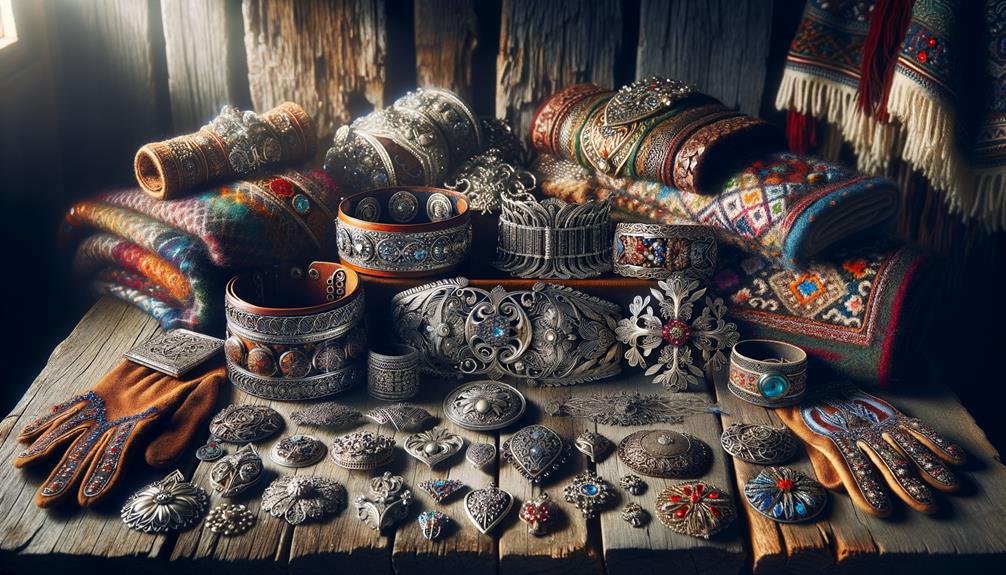
Norwegian bunad accessories showcase intricate silver filigree craftsmanship interweaving heritage stories. Each brooch, earring, or traditional bunad knife validates artistry passed down generations. The belts, often adorned with silver filigree patterns, bring bunad costumes to life with exquisite detail enhancing overall elegance. These accessories embody cultural significance, making each bunad a unique Norwegian tradition.
Observing the meticulous designs instills deep respect for artisans pouring skills and passion into each piece. Their work ensures celebration and cherishing of traditional costume beauty and authenticity. The bunad accessories transport us to regional ties and customs defining Norwegian culture through their delicate, hand-crafted elegance.
Preservation and Care
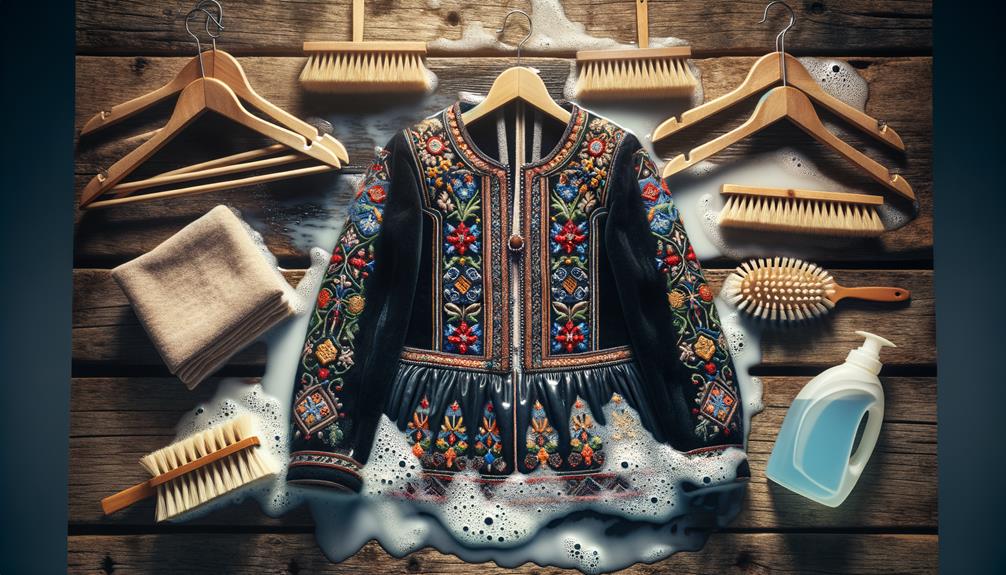
Bunads represent intricate craftsmanship, making proper care crucial for their preservation. Cool, dark storage prevents fabric discoloration and intricate embroidery damage. Regular cleaning with material-specific methods extends the garment's lifespan. Avoiding direct sunlight and humidity safeguards delicate textiles. For expert guidance on restoration and upkeep, consult professional preservation services.
A quick reference:
| Aspect | Action | Benefit |
|---|---|---|
| Storage | Cool, dark areas | Minimizes fading, deterioration |
| Cleaning | Routinely, per material needs | Maintains pristine condition |
| Light Exposure | Limit direct sunlight | Protects colors, embroidery |
| Humidity Levels | Keep low | Prevents fabric, embroidery issues |
| Expertise | Seek professionals | Ensure proper care, restoration |
Frequently Asked Questions
Can Anyone Wear a Bunad?
I've noticed people from diverse backgrounds embracing the bunad, a traditional Norwegian garment. Despite varied heritage, there seems to be a welcoming spirit surrounding this cultural attire. It reflects unity and a respect for skilled craftsmanship. The bunad's modern popularity exemplifies an admirable openness and inclusivity.
What Is a Bunad in Traditional Norwegian Clothing?
A bunad represents Norway's cultural heritage, with intricate embroidery and silver adornments specific to each region. Donning these vibrant outfits during celebratory events is a prideful nod to the country's diverse traditions, each bunad conveying a unique story woven into its design.
How Expensive Is a Bunad?
A bunad can set you back anywhere from $2,000 to $10,000. The premium pricing reflects the quality materials and intricate craftsmanship involved, especially for custom pieces meticulously handcrafted to preserve cultural traditions. Consider it a long-lasting investment in artistry and heritage.
How Do You Pronounce Bunad?
Pronouncing 'bunad' is a chance to honor Norwegian heritage through language. The word rolls naturally off the tongue as 'boo-nahd,' capturing nuances that shift between regional dialects. Getting it right goes beyond mimicking sounds – it's about embodying cultural traditions with every syllable.



